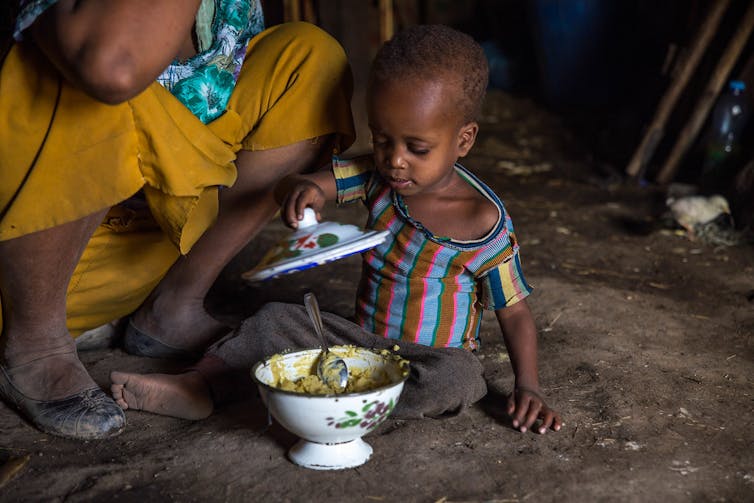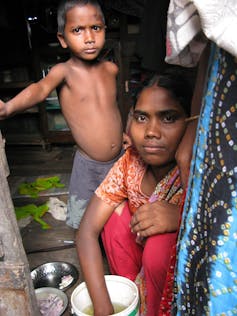
Actions needed to promote children’s growth in poor urban areas
The United Nations estimates that there are at least 1 billion people living in urban slums – poor areas in cities without adequate access to health care, clean water and sanitation. More than 90% of urban slums are in low- and middle-income nations, and the residents usually live in poverty and face insecurities in food, housing and more.
In many of such areas, programmes and schemes by government and NGOs are provided to help families and mitigate malnutrition. But are these effective?
Understanding stunting
We just completed a Cochrane Systematic Review “Nutritional interventions for preventing stunting in children (0 to 5 years) living in urban slums”. These are systematic assessments of primary research, and are internationally recognised as the highest standard in evidence-based health care.
Our review provides a transparent and objective evaluation of the effectiveness of treatments designed to improve health. “Stunting” is the term used to describe very short height, technically a girl or boy whose height-for-age is among the shortest 2.5% of a healthy reference group of children.
In some of the low-income countries where we work, such as Bangladesh and India, up to 60% of the urban slum children measured fall into this category. Stunting is associated with poor health, poor school performance, and the likelihood of life in poverty both now and in the future.

Our review included 15 studies, involving 9,261 children across the world less than five years old and 3,664 pregnant women.
The interventions by NGOs, research organisations or government-provided maternal nutrition education, nutrient supplementation of mothers, infants, and children, such as adding zinc or iron, nutrition systems strengthening, or a combination of these.
None of the studies modified the diet by providing additional food to families from locally available sources and allowing them to use it as they best saw fit.
The scientific quality of the studies on these interventions was judged to be very low to moderate overall, because studies were not designed to cope with research problems linked to urban slum communities, such as families repeatedly moving, making it difficult to keep providing supplements or monitoring children’s height. This meant that the effectiveness of the intervention could not be properly assessed at later dates.
Nutritional interventions are not as effective as they should be in poor urban areas
We found four main results.
- There was no evidence of an effect of giving pregnant mothers zinc supplementation on the birth weight or length of their new-borns.
- There was no evidence of an effect or unclear evidence of nutrient supplementation increasing height of children.
- There was inconclusive impact of interventions supporting nutrition activities within health services.
- However, educating mothers on good nutrition when they were pregnant did help to increase birth weight.

Another systematic review of studies that did provide additional food to families came to a similar conclusion: “Supplementary food effects are modest at best”.
These results show that new approaches are needed to promote the nutritional status of children living in urban slums or any other place where families live in poverty.
These findings indicate that equating stunting with malnutrition is a gross simplification of reality. A complex matrix of interacting factors – physical, environmental and emotional in relation with poverty – are the cause of stunting. All need to addressed together to reduce stunting.
Addressing insecurities
People rich and poor are acutely aware of insecurities of any type – think about your own insecurities, perhaps your next performance review or your relationship with a significant other.
Insecurities increase feelings of stress, raising the level of stress hormones (such as adrenalin and cortisol) in our bodies.
Chronic stress in pregnant women and in their families inhibits the hormones responsible for growth of the skeleton and this results in smaller new-borns and in shorter children.
Parents try to do everything possible to reduce stress for their children, but the constant pressure of poverty and insecurity in slum environments overwhelms them.

When seemingly hopeless slum conditions are changed, child health then improves. Our analysis of a comprehensive, community-based prevention and treatment programme in a slum in the western coastal city of Mumbai, India, found that it cost only US$23 per child to provide one year of improved growth and health.
The organisation, SNEHA, worked in Dharavi, one of the largest urban slums in Asia with an estimated population of 700,000 to more than 1 million.
The programme in partnership with ICDS provided growth monitoring, counselling, referrals, support access to treatment, and a food supplement at a day-care centre to infants and children with severe or moderate malnutrition (wasting or thinness) for 12,000 children in one year. It also provided monthly door-to-door home-based counselling for caretakers of better-nourished infants to promote appropriate feeding practices, immunisations and awareness of health problems to prevent malnutrition.
The community health workers delivering this programme were well accepted as they were from the slum themselves and were able to provide recommendations to the local government at district, and Greater Mumbai level to improve health care delivery policies.
Regular growth monitoring of children, intensive home visits by trained, motivated and well supervised community health workers, and referrals to locally available primary care contributed to the success of the program. Children were less malnourished children after the programme.
Hope is what people need
Fine-tuning the strategies and processes as per the need of the community, beneficiaries and public health system helped in effective implementation. In a low- and/or middle-income country like India, collaboration with NGOs for robust community engagement and liaising with public health system is very useful.
Our systematic review shows the need to better understand urban slums and their families. Our Mumbai slum analysis shows that appropriate, acceptable, and low-cost interventions can prevent and treat growth failure.
Successful interventions raise awareness, prevent malnutrition, give families the ability to care for their children and provide hope for the future. Sustaining hope requires action ‘upstream’ from the urban slum – at the level of government and private businesses – to change social, economic and political processes and reduce insecurities in water, sanitation, food, housing, education and health care. Change leading to a hopeful future is the best way to healthy growth of children in poor urban slums.
Feature Image: Children in a Bangladesh slum. United Nations /Flickr, CC BY-ND
This article is republished from The Conversation under a Creative Commons license. Read the original article.




